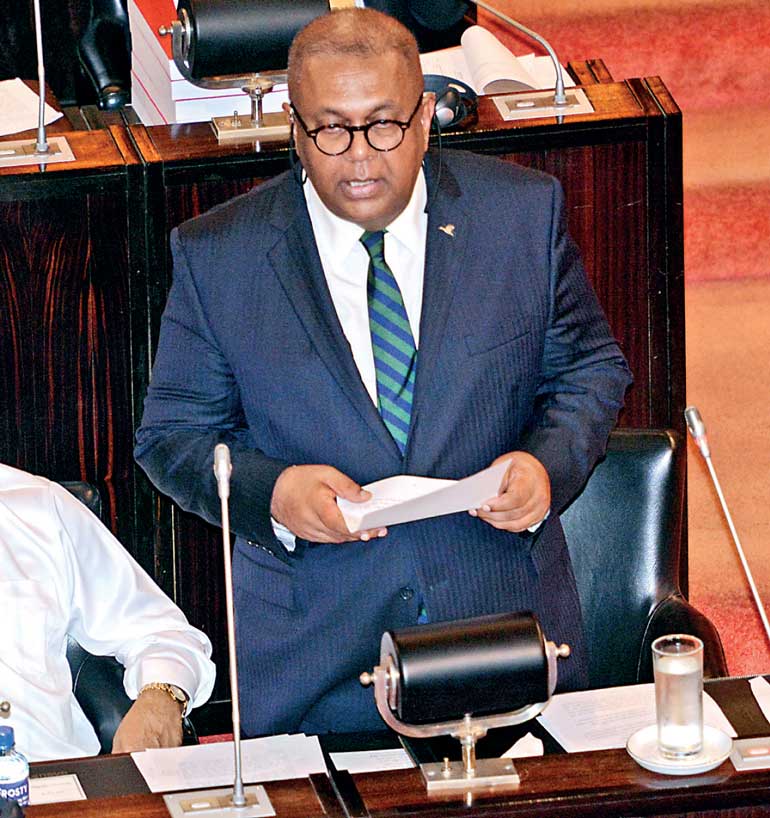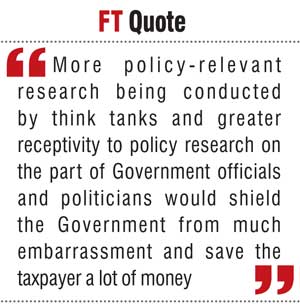Saturday Apr 19, 2025
Saturday Apr 19, 2025
Monday, 20 November 2017 00:00 - - {{hitsCtrl.values.hits}}

Finance Minister Mangala Samaraweera
Every Budget Speech includes complex policy measures. Given the traditions associated with the Budget Speech, it is not possible to conduct public consultations on each of the measures beforehand. But without extensive consultation and input from persons with deep subject knowledge, the proposals will be half-baked. They are likely to contain significant errors, may not achieve the stated objectives and worst of all may cause harm.
Ideally, teams of officials in the line ministries as well as in the ministry or ministries responsible for overall coordination (e.g., Ministry of National Policies and Economic Affairs, Ministry of Finance) will be permanently engaged in research on solutions to various policy problems. Their findings will be easily retrievable by senior policymakers on occasions when they have to respond to a crisis or demand of some kind or have to prepare a Budget Speech or brief a new Minister. These occasions are described in the academic literature as policy windows.
Lack of knowledge within Government
Unfortunately, this ideal scenario is unlikely under the conditions currently prevailing within Government in Sri Lanka. Senior officials are consumed by mundane matters and ceremonies. With a few exceptions, most are not attuned to research or even to systematic data collection and synthesis.
The proposal included in the 2018 Budget Speech to impose a levy of Rs. 200,000 per mobile antenna tower, per month, is a good example.
 The Minister is ill-informed even on the number of towers that are to be subject to the levy. In Parliament he had stated that there are 50,000 towers. If Rs. 2.4 million is collected annually from 50,000 towers, the yield will be Rs. 120 billion, eight times what the Budget Speech states is the expected yield from both the tower levy and the tax on bulk SMS, Rs. 15 billion.
The Minister is ill-informed even on the number of towers that are to be subject to the levy. In Parliament he had stated that there are 50,000 towers. If Rs. 2.4 million is collected annually from 50,000 towers, the yield will be Rs. 120 billion, eight times what the Budget Speech states is the expected yield from both the tower levy and the tax on bulk SMS, Rs. 15 billion.
The tower levy is unlikely to result in the quick consolidation of antennae to fewer towers because tower sharing is already happening and in most cases, mounting additional antennae on existing towers is not practically possible because of the weight they (or the underlying structures) have been designed to carry. The likely outcome is the shutting down of marginal towers, harming the quality of service in the cities and loss of service in some rural areas.
The evidence suggests that the drafters of the speech failed even to consult the Telecom Regulatory Commission, which is the governing body with the relevant expertise. Ignorance of technology is rife. According to a Minister who has an engineering degree, a total of nine towers can carry all mobile telecom signals in Sri Lanka.
The claim that fewer towers will yield health benefits is also fallacious. The fact that cellular networks require a large number of low-power base-transceiver stations because the same frequencies are reused in non-adjacent cells appears to have been missed by those who grew up in the age of tall analogue broadcast towers that transmitted at full power.
A second-best solution
Until such time as we can reform the administrative service and remedy the ignorance of our ministers, what can be done to avoid the embarrassment of half-baked policy measures that have to be walked back or quietly buried when stakeholders and outside experts demonstrate their flaws?
The solution is for think tanks to conduct research on various policy options and make available their findings to policymakers in easily absorbable forms. And for policymakers to be open to such research.
The 2018 Budget’s proposal contains a proposal that exemplifies the elements of workable solution:”Farmers are constantly at the mercy of the weather gods and successive governments have been doling out funds to the farmers whenever there has been a drought or floods in an indiscriminate manner. It is in this context that the weather indexed insurance scheme has been designed. The insurance cover will be a minimum of Rs. 40,000 per acre for six crops including paddy and other five emerging crops such as maize, soya, big onion, potato and chilli. This will be a contributory scheme with the premium being borne by both the farmer and the Government.
The Government will invest Rs. 3,000 million in 2018. To support such ventures we will also upgrade the Department of Meteorology with state-of-the-art technology and elevate the capacity of the personnel.
Weather-indexed crop insurance is gaining acceptance in countries such as India, Kenya and Ethiopia as an alternative to indemnity-based crop insurance. It is new to Sri Lanka. The payout in the index-based form is based on a parameter such as rainfall. It does away with field assessments and closes off opportunities for extracting bribes. It is characterised by low transaction costs and addresses the moral-hazard and adverse-selection problems associated with indemnity-based insurance.

The language in the Budget Speech did not emerge fully formed from within the Finance Ministry. Late last year, the Institute of Policy Studies posted an entry in its ‘Talking Economics’ blog describing the policy instrument and identifying problems such as the lack of weather stations and delays in reporting. In November 2016 and January 2017 local newspapers carried reports on IPS’ work on weather-indexed insurance. Possibly more coverage occurred in electronic media and the Sinhala press. The message got through.
The very fact that Rs. 200 million is to be allocated to the Department of Meteorology for upgrading its technical and human capabilities is indicative that the research had impact. The fact that the proposal is for six crops at the outset suggests that the need to start small and learn from the first few seasons has been internalised.
Why can we not have more of these successes? More policy-relevant research being conducted by think tanks and greater receptivity to policy research on the part of Government officials and politicians would shield the Government from much embarrassment and save the taxpayer a lot of money.
LIRNEasia, the think tank I am associated with, may be able to contribute to effective implementation of weather-indexed crop insurance. In collaboration with the University of Moratuwa, we are in the process of obtaining funds for research on how to tell localised weather from the mobile networks using a method proven in the Netherlands and Israel. It will use the rain-induced attenuation of microwave signals among the ubiquitous mobile antenna towers (that the Government is trying to shut down) to supplement the rainfall data from conventional weather stations.
In an ideal world, a small part of the Rs. 200 million allocated for buying equipment for the Department of Meteorology would be used to support this kind of direct policy-relevant research. But the research will be done and the findings shared with policymakers, even in the non-ideal world we live in.
Discover Kapruka, the leading online shopping platform in Sri Lanka, where you can conveniently send Gifts and Flowers to your loved ones for any event including Valentine ’s Day. Explore a wide range of popular Shopping Categories on Kapruka, including Toys, Groceries, Electronics, Birthday Cakes, Fruits, Chocolates, Flower Bouquets, Clothing, Watches, Lingerie, Gift Sets and Jewellery. Also if you’re interested in selling with Kapruka, Partner Central by Kapruka is the best solution to start with. Moreover, through Kapruka Global Shop, you can also enjoy the convenience of purchasing products from renowned platforms like Amazon and eBay and have them delivered to Sri Lanka.
Discover Kapruka, the leading online shopping platform in Sri Lanka, where you can conveniently send Gifts and Flowers to your loved ones for any event including Valentine ’s Day. Explore a wide range of popular Shopping Categories on Kapruka, including Toys, Groceries, Electronics, Birthday Cakes, Fruits, Chocolates, Flower Bouquets, Clothing, Watches, Lingerie, Gift Sets and Jewellery. Also if you’re interested in selling with Kapruka, Partner Central by Kapruka is the best solution to start with. Moreover, through Kapruka Global Shop, you can also enjoy the convenience of purchasing products from renowned platforms like Amazon and eBay and have them delivered to Sri Lanka.